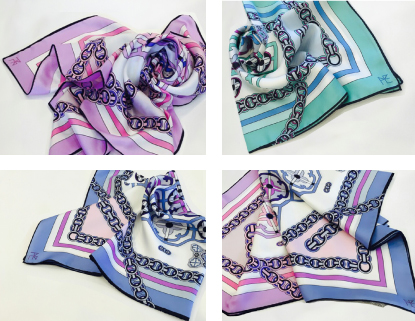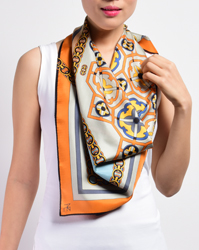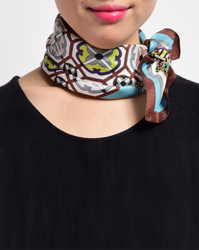SCARF
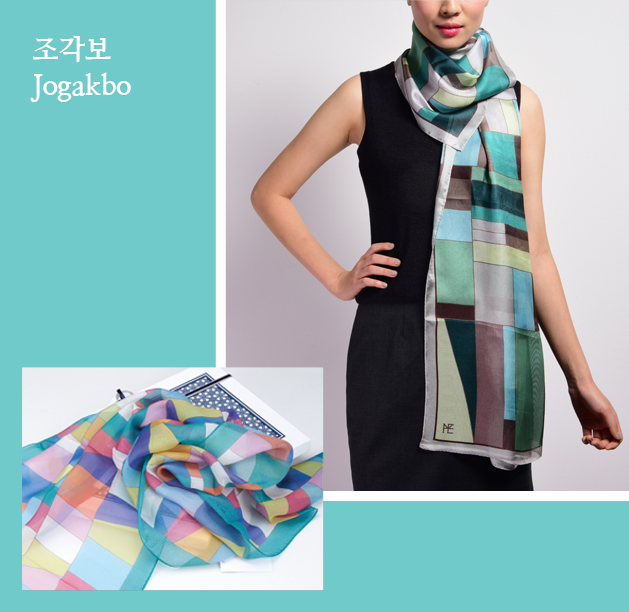
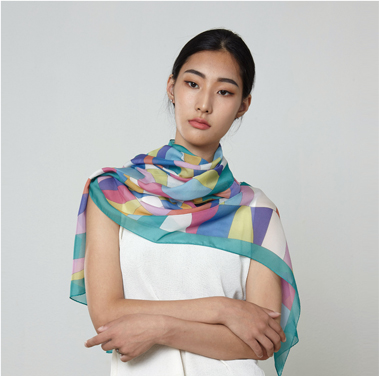
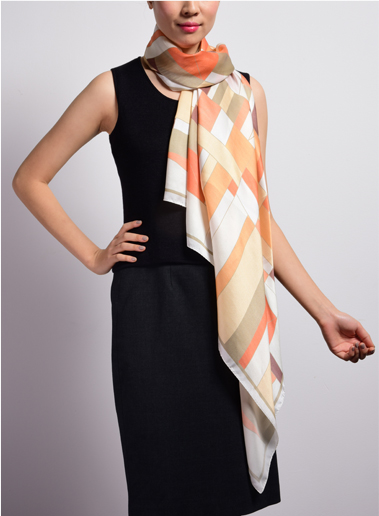
- 조각보
- Color puzzling GR, 90x90cm silk satin georgette
Color puzzling OR, 90x90cm, 110x110cm, silk satin georgette
Color puzzling 2 OR, 55x180cm, silk mesh - 남은 조각의 천들을 이어 하나의 예술적 조형물로 창조된 19~20세기 초 조각보는 선조들의 검소함, 독창적인 멋과 얼을 엿볼 수 있습니다.
조각을 이어나간다는 연장 개념은 장수를 축원하는 의미를 담고 있습니다.
- Jogakbo
- Jogakbo from the 19th to early 20th centuries are artworks that result
from patching small pieces of leftover fabric together. They reflect our ancestors’ frugal life style as well as their innovative minds and spirit. The idea of “extending” the patchwork by connecting the pieces expresses wishes and prayers for longevity.
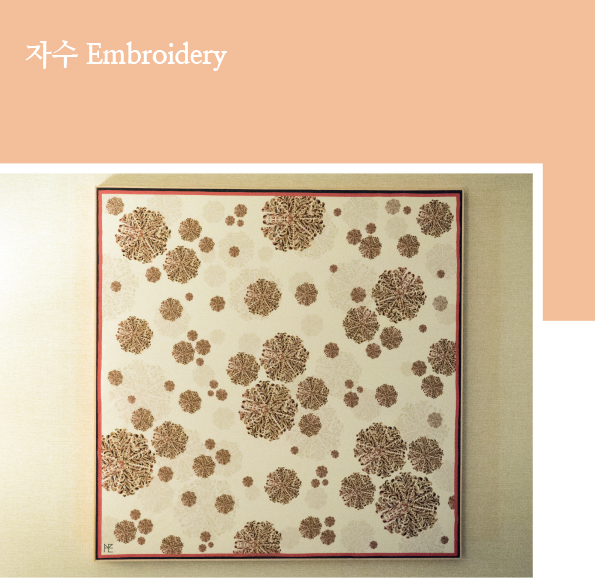
- 화문 수보
- Lady’s flower embroidery 2, 50x50cm, 90x90cm, silk satin georgette
- 넝쿨과 화문이 모여 하나의 무늬를 이루며, 복과 즐거움을 기원하는
문양으로 혼례 등의 길사에 사용되었습니다. 한국자수박물관에 소장된
19세기 화문 수보에서 모티브를 가져와 다양한 컬러로 재탄생하였습니다
- Hwamun Soobo
(Flower-embroidered clothwrapper) - A harmonious pattern consisting of vines and flowers, this image express
wishes for blessings and joy. This pattern was used in weddings and other
auspicious events. Motifs were taken from the 19th century clothwrappers
in The Museum of Korean Embroidery and have been recreated in various
color palettes.
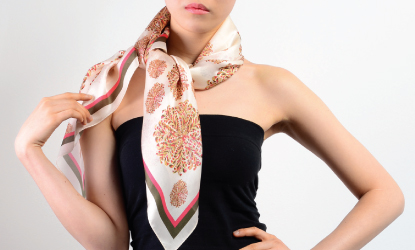
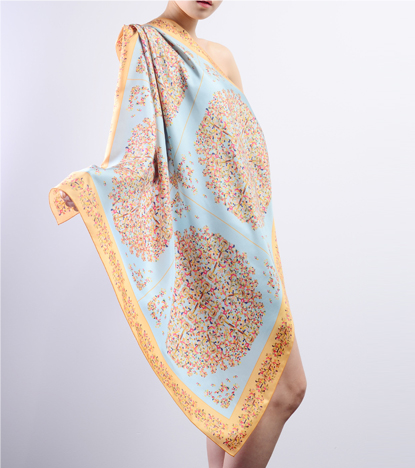
- 수화문
- Flower garden in Chosun dynasty 1 BL, 90x90cm, silk twill
Flower garden in Chosun dynasty 2 OR, 90x90cm, silk twill - 오방색을 중심으로 여러 색실으로 보석을 박은 듯 수놓은 수보는 주로 복을 기원하는 길상으로 사용
되었다. 나무와 꽃을 그린 수화문은 19세기 말에 주로 미혼여성이 혼례용으로 만들었던 수보에 가장
많이 사용되었다. 한국자수박물관에 소장된 수화문보를 재편성하여 현대적 색상으로 덧입혀 보았다.
- Suhwamun (Embroidered Flower Pattern)
- Subo is a multi-coloured wrapping cloth that symbolizes good fortune. Five Korean traditional
colours, obangsaek, are used along with other colours to make the embroidery look like beautiful
jewels. Suhwamun illustrates flowers and trees, and was often used in Subo clothes made by
brides-to-be in the late 19th century. This scarf was retouched with modern colours to the
suhwamun cloth which is housed in the Museum of Korean Embroidery.
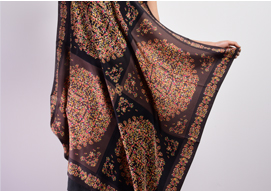
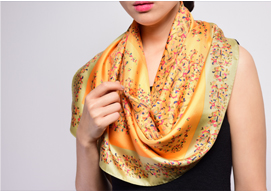

- 문방사우 민화
- Scholar’s Essence in Chosun 1 GR, 110x110cm, wool silk(wool 35%, silk 65%)
Scholar’s Essence in Chosun 2 BL, 90x90cm, 110x 110cm, silk satin georgette - 학업과 덕행에 힘쓰라는 교훈적인 의미를 담고 있습니다. 혜에서는 책거리
그림과 화초를 함께 표현한 민화 속의 문방사우를 택하여 왕실에서 사용하던 꽃창살을 바탕문양으로 왕실문화와 민간예술을 조화시켜 현대미를
더하였습니다.
- Folk Painting of Four Treasures of the Study
- This conveys a moral message telling us to give great efforts in studying and doing good deeds. HYE selected the four treasures from a folk painting that illustrates books and flowering plants, and then combined them with the flower lattice pattern used by the royal family. The result is a combination of royal culture and private art, with a touch of modern beauty.
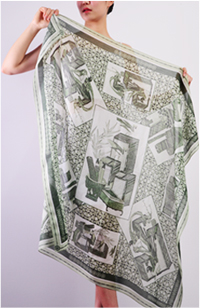
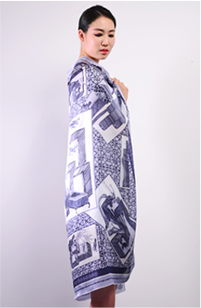
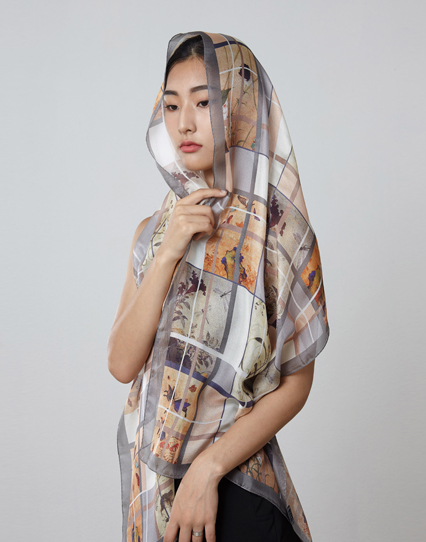
- 초충도 민화
-
Misty color in Korean nature 1 GY, 55x180cm, silk mesh
Misty color in Korean nature 2 LB, 55x180cm, silk mesh
Misty color in Korean nature 3 BR, 55x180cm, silk mesh - 작은 풀벌레를 그린 초충도는 예로부터 조용하고 그윽한 정감으로 사람들에게 남다른 즐거움을 주었습니다.
초충도 속 꽃과 나비의 조화는 번영을 의미하여 신혼부부의 안방에 즐겨 사용되어 왔습니다. 초충도 민화와
격자 모양을 조화시켜 현대적으로 표현하였습니다.
- Folk Painting of Plants and Insects
- Plant and insect paintings feature small bugs, and they gifted the viewers with special joy with their quiet and calm images. The flowers and butterflies in these folk paintings symbolize prosperity.
For this reason, this combined imagery was favored in the rooms of newlyweds. We have used plant and insect folk paintings along with grid patterns to produce a contemporary image.

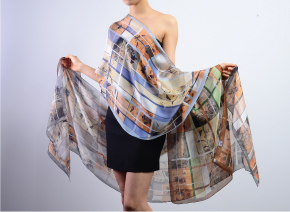
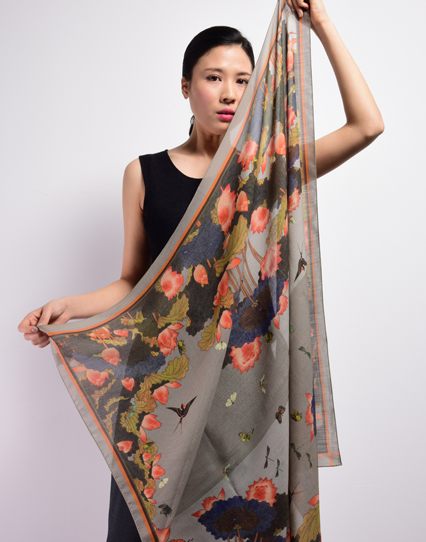
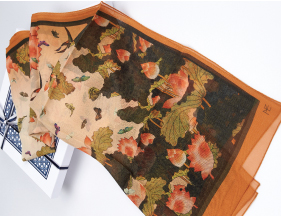
- 연화도
- Lotus Painting, 55x180cm, silk chiffon
- 기독교에서 박애와 사랑의 상징을 백합꽃으로 형상화하는 것처럼 불교에서는 대자대비를 연꽃으로 상징하고 있습니다.
즐거움, 행복, 희망의 의미를 가진 나비와 합성하여 19세기 민화를 새롭게 연출하였습니다.
- Lotus Painting
- In Christianity, lilies stand as symbols of love and love for all mankind. Likewise, lotus flowers represent great love and great compassion in Buddhism. Here, a unique and novel version of 19th century folk painting is created by using lotus flowers with butterflies which symbolize joy, happiness and hope.
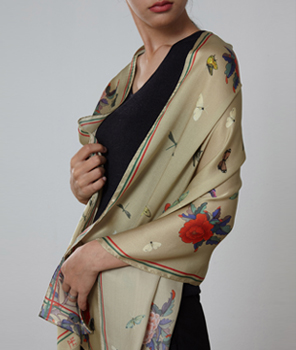
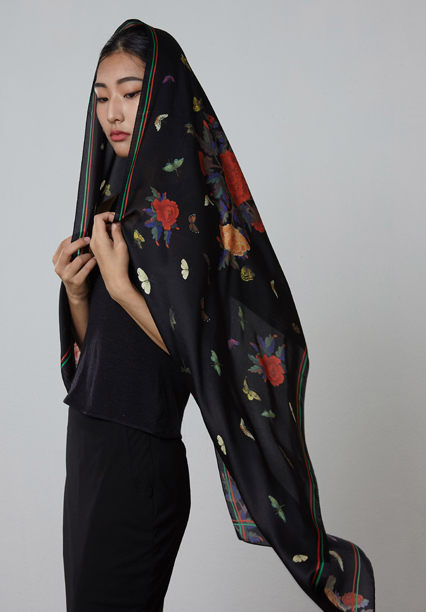
- 모란도
- Morando 1 BK, 55x180cm, silk satin georgette
- Morando 2 OL, 55x180cm, silk satin georgette
- 모란은 예로부터 동양에서는 부귀의 상징이었으며, 꽃 중 왕으로 임금을 상징하며, 그 자태와 화려함으로 부귀영화와 안락과 남녀의 화합을 나타낸다.
- Morando (Painting of Peonies)
- Peonies have long been known as a symbol of wealth in Asia. Peonies are the king of flowers and represent the emperor in Asia. Their graceful appearance and magnificence symbolize affluence, honour, well-being and harmonious couples.

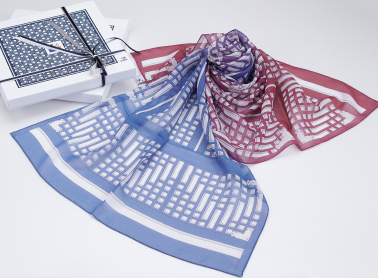
- 창살문
- Chosun glazing bar 1 GR, 55x180cm, silk chiffon
Chosun glazing bar 2 PL, 55x180cm, silk chiffon - 우리 선조는 문과 창을 안과 밖을 이어주는 연결고리로 자연을 내부로 연결시켜 자연과 일체가 되게 하는 건물의 화룡점정으로 사용
하였습니다. 여기서의 창살은 창덕궁 낙선재에 있는 창살로 빛을 보는 각도에 따라 창살의 형태가 변화하며 신비한 멋을 자아냅니다.
- Latticed Door
- Korean ancestors used doors and windows to connect interiors with exteriors. Doors and windows were key elements that brought nature to the inside and transformed the interior to become one with nature. The lattice here was taken from Nakseonjae in Changdeokgung Palace. Depending on the angle from which the light is shone, the shape of the lattice changes and creates a magical effect.
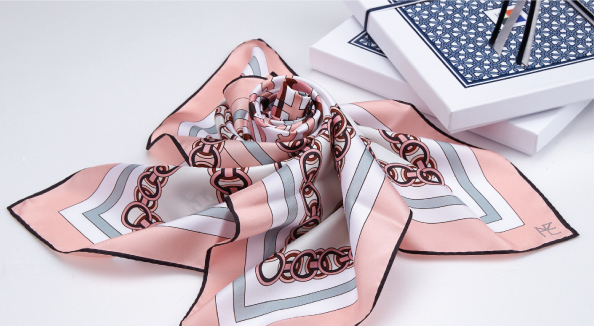
- 여의문과 고리금문
-
Chain pattern PK, PP, BL, GN, 90x90cm, silk twill
Chain pattern petit GN, BL, RD, 55x55cm, silk twill - 여의주 4개로 이루어진 여의형은 도교적 상징에서 ‘뜻하는 대로’를 의미합니다. 원, 타원, 동심원 등을 좌우로 연속시켜 마치 사슬이 꿰어진 모양을 이룬 연속무늬는 불교에서는 윤회를 상징하는 도형이며, 장수를
의미하는 길상무늬입니다. - Cintamani Pattern and Chain Pattern
- Cintamani pattern consists of four cintamani stones, or pearls of dragons, connected together. It is reflective of the “as you wish” philosophy derived from Taoism. Continuous chain pattern resembles silk weavings, and this chain of circles, ovals and concentric circles connected side by side signifies the cycle of life, death and rebirth in Buddhism. This is also a pattern of good fortune, signifying longevity.
